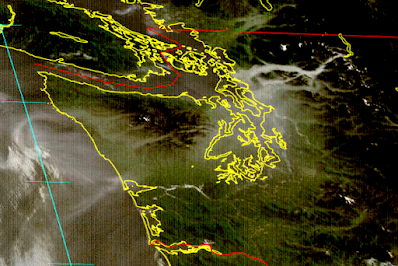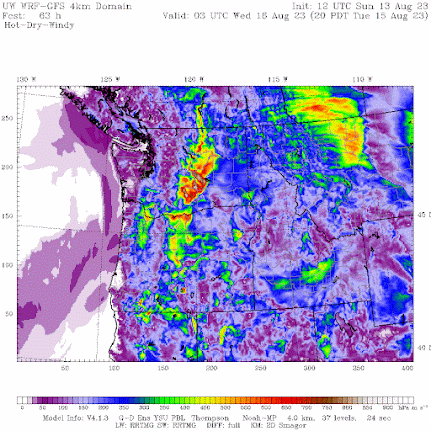While deserved attention is being given to the terrible tragedy on Maui, a significant wildfire threat now exists over our area.
Before I discuss the situation, let me note that wildfire smoke has entered western Washington...and one can smell it in Seattle.
Smoke is coming from the only significant fire burning in Washington State, the lightning-initiated Sourdough fire in the North Cascades. The latest PurpleAir sensor map shows moderate air quality (yellow) over central Puget Sound and much worse numbers near Ross Lake in the north Cascades.
The smoke was even apparent in this morning's visible satellite imagery, moving down the Skagit River valley, into Puget Sound, and even offshore. Reminds me of the Bolt Fire situation, just farther north.
But this is not the fire threat I am talking about.
With high pressure building inland today, forcing easterly flow over the Cascades, a trough of low pressure has formed over the Willamette Valley (see map for 11 AM today). The figure shows pressure (solid lines), low-level temperatures (shading), and surface winds.
This is a warm pattern of the Willamette Valley, with temperatures in Portland forecast to rise to about 100F today and to 106F tomorrow, a major cool down will follow later this week.
In contrast, Seattle, with less easterly flow and more water influence will rise to about 90F before the cool-down.
Eastern Washington will be toasty on Tuesday and Wednesday, approaching 110F before the cool down at the end of the week.
Looking at the extended forecasts and considering the time of the year, I suspect this will be the Northwest's last significant heatwave of the season.
Wildfire Fire Potential
As tragedically demonstrated in Maui, strong winds are an essential part of a wildfire disaster. One of the best measures of wildfire threat, the index Hot-Dry-Windy, combines wind speed and dryness.
The latest UW forecast of Hot-Dry-Windy shows high values (orange and red) in the Willamette Valley at 8 PM tonight.
While the HDW forecast for Monday evening increases the danger around Portland.
On Tuesday, as the pressure pattern shifts, strong winds and substantial fire danger moves to the eastern slopes of the Washington Cascades and near the Columbia Gorge. Folks need to be very careful not to start any fires there...this is dangerous.
I can't stress enough that WIND is the key to the worst wildfire situations. And my profession is increasingly able to predict it skillfully during the next few days. But society needs to be able to use these skillful predictions effectively, something that failed in Maui.
________________________________







.gif)




Fortunately, the air quality has been good around Bellingham today with no wildfire smoke-related degradation. Unfortunately, however, it's been rather muggy with dew point temperatures in the mid-high 60s; uncomfortably warm by PNW standards.
ReplyDeleteCliff is correct to state that wind has been the main driver of large wildfires, but a necessary first condition is for fuels to become dry. If they are wet, even the strongest wind will not result in significant spread, so the degree of heat and dryness prior to and with the fires is of primary importance. Also, fires such as the Sourdough fire, can grow larger even without significant wind as they are in steep, dry forested areas where convective upward motion will carry the fires uphill and spotting and downhill rolling fire brands will expand it.
ReplyDeleteSee Cliff's numerous wildfire posts which mention 1-10 hour fuels that dry out very quickly. It could have rained yesterday and these fuels will be dry enough to burn today.
DeleteYes the lighter grass and small diameter fuels dry out quickly but the Sourdough fire and other similar forest type fires are burning in larger fuel types which take much longer to dry out and require a longer (weeks) period of warm, dry weather to do so. Unless these larger fuels are dry, a fire starting in the small forest fuels usually do not become large, but just smolder around in the smaller fuels. And while grass fires can occur fairly shortly after a rain, they still require a drying period and I think you will find that most of our larger grass fires have been preceded and accompanied by a more extended warm, dry period.
DeleteYikes for those east side and Portland forecasts. The "substantial" cool down later in the week is only relative to the highs on Mon and Tuesdays, but still above normal highs.
ReplyDeleteHere's to hoping we manage this without any major fire starts.
Last night here in Portland was fairly bad, and the next few days look to be worse, shades of 2021 (but not at that level). But how informative it would be if our local media here would attempt to highlight real - world solutions to their impending cries of doom; to take just one of hundreds of examples:
ReplyDeletehttps://www.nextbigfuture.com/2023/08/generfal-fusion-funded-to-build-scientific-breakeven-fusion-machine-by-2026.html
Fusion has been touted for decades so a good degree of skepticism is warranted, but why not highlight these emerging technologies instead of focussing on wasteful and inefficient "green" taypayer boondoggles like wind turbines and solar? There are also many new nuclear fission plants finally coming online soon, despite the vehement objections of the enviro NGO's and their related PAC's.
https://www.reuters.com/business/energy/us-approves-design-nuscale-small-modular-nuclear-reactor-2023-01-20/
These plants are small scale yet emit close to zero CO2, and also recycle their spent nuclear fuel. They're scalable, efficent and the can help our country power itself into the rest of the century.
Hope you can stay cool and comfortable during the heatwave.
DeleteInteresting articles, in particular the fusion one. Skeptical indeed, given the history, but if it can be made to work that's awesome.
I am pro-nuclear and am frustrated by attitudes toward nuclear power on the left. It's an obvious solution to CO2 emissions and the common objections aren't very persuasive to me.
I am more favorably disposed to wind and solar power, however. They're already proving themselves are viable and the tech will surely continue to improve, including storage and distribution. I think pulling back from wind and solar in favor of less advanced tech (e.g. fusion) entails a bit too much risk and faith in currently unproven methods.
Windmills are admittedly a "blight on the landscape"- but I see no real objection to solar. Done wisely, it need use little additional land. Panels could be installed on roofs and over freeways, rail lines, and parking lots on posts. Think of the incidental benefits: Everyone could park in the shade on hot days. The biggest hurdle for solar is the energy storage- and we are working on it.
DeleteI suspect people thought powerlines were a blight on the landscape when they first started going up in towns and cities. And then we all accpeted them as a part of modern life, and because we like electricity.
DeleteAesthetics don't strike me as a compelling reason to turn away from wind power.
I was out hiking in the ALW area close to Tucquala lake on Friday. I was struck by the state of the forests from Fish Lake all the way along FS 4330 back to Roslyn. I have never seen so much deadfall and buildup of brush and logs in a forest. Several acres of forest appear to be completely dead and it's also exceptionally dry as the clay like soil in that area dries out rapidly. It's sad to see that through fire suppression we have created an inferno just waiting to happen.
ReplyDeleteAccording to records, outside of the Jolly Mtn fire, this area hasn't burned but boy is it primed. The area is heavily populated with car campers many of whom are target shooting and running generators etc. Its actually quite amazing that there hasn't already been a fire.
More terrifying is that there are entire communities of luxury homes and vacation rentals that have been built high up in steep forested terrain along Cle Elum Lake. This would be a disaster in a fire since the only egress is along Salmon la Sac road which could easily be cut off. I'm not sure to whom we need to raise these issues to make any progress, or do we just sit and wait for a fire to correct our mistakes?
I was the lead author on a science paper in the spring of 1994 from the Wenatchee National Forest and the Forestry Sciences Lab in Wenatchee to the Clinton Administration.
DeleteThe science paper was on the topic of fire and other threats to Spotted Owls on the east slope of the Cascades. The point was that given the fire history on the east slopes, a strategy based on western Oregon and Washington ecology was NOT going to work.
The fire folks on the team were quite certain that they could hold any fire in Chelan County to 50,000 acres. It was Kittitas County and the upper Cle Elum valley that gave them nightmares. It was where they a expected a man-caused start during a Red Flag period, to grow to over 100,000 acres in a relatively short time.
They were wrong. That summer the Tyee Fire in Chelan County went to 140,000 acres. We still have not had that 100,000 acre fire in Kittitas County, but the clock is still ticking.
Kittitias County has been a leader in fire protection in the past 30 years. Unfortunately, as you noticed the National Forests are still being managed like it is 1993. Sooner or later the luck will run out and a fire coming down from the Wenatchee National Forest will devastate upper Kittitas County.
What can you do about?? You need to change the politicians mindset on public land management.
Oh, by the way, according to my wildlife biologist friend in 1993 there were 100 spotted owls in Chelan County. Today the population is down to ONE.
I wish we were wrong in our scientific assessment.